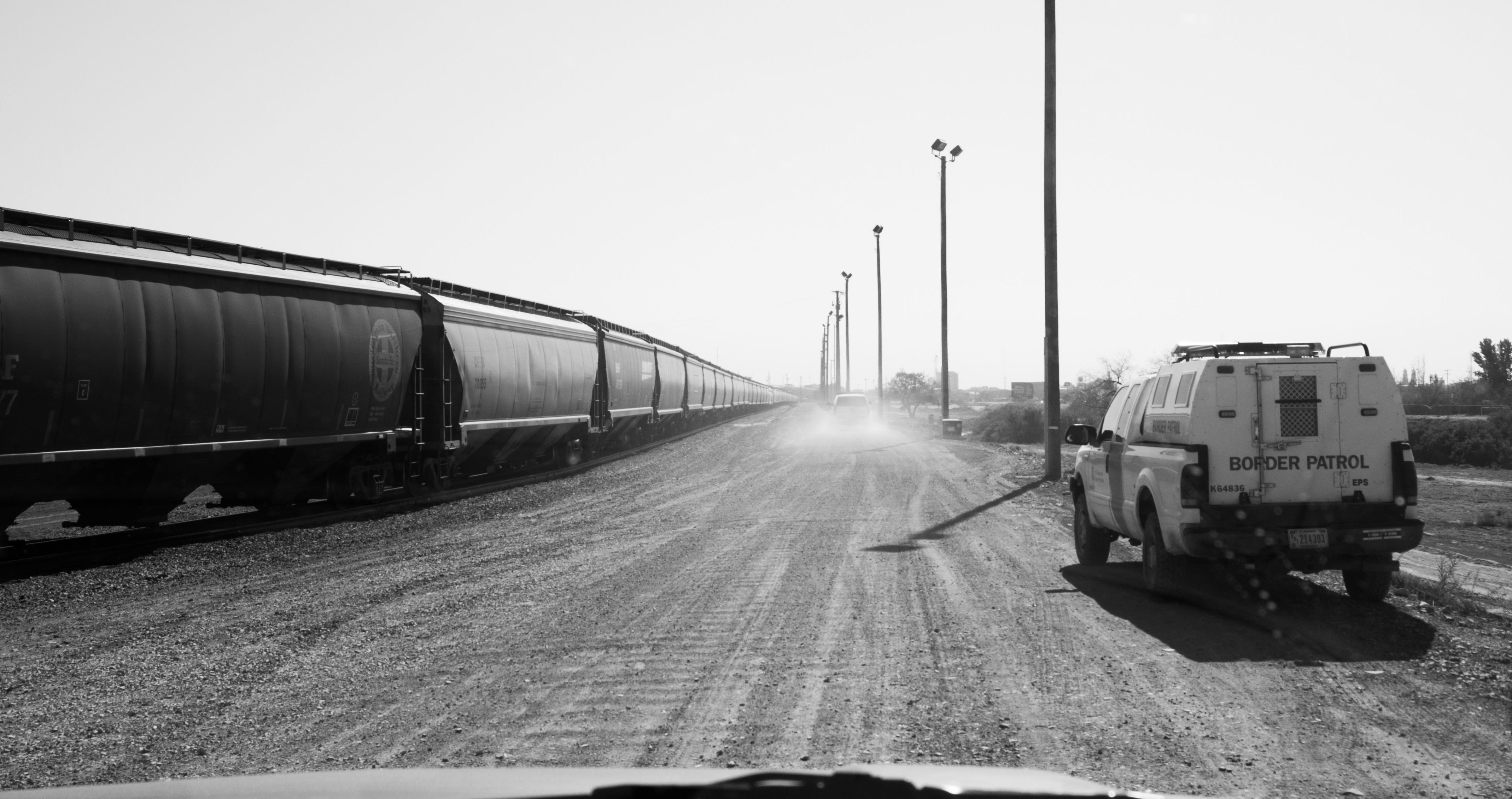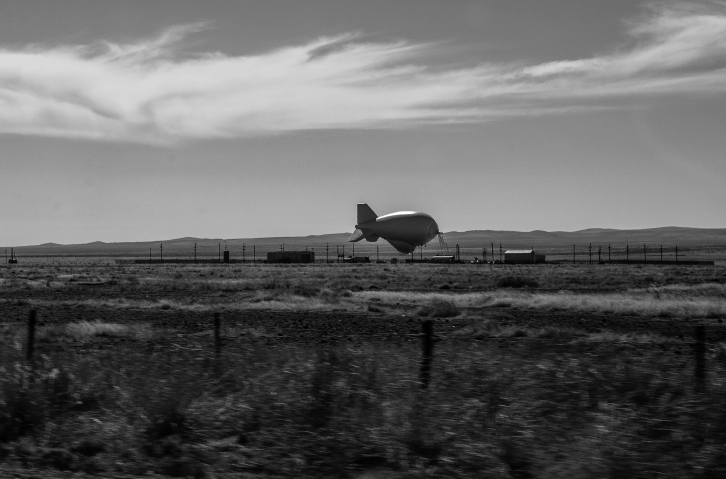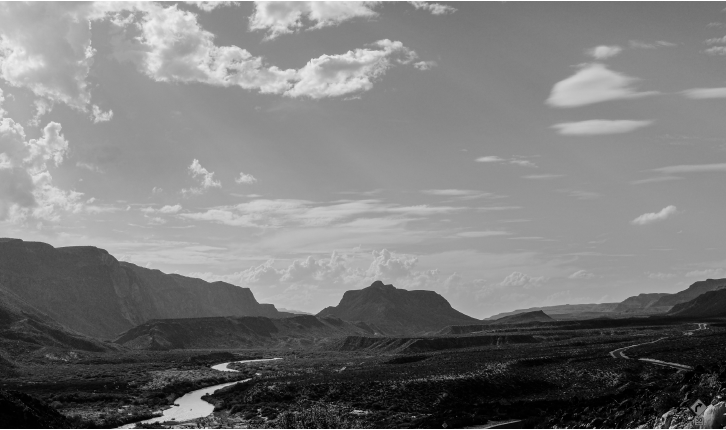
We used to think of the US-Mexico border as a line separating two countries—a place, a region, and, if you lived there, a vibrant community. For most people in the United States, however, the border was someplace far away where different rules applied. No longer. Over the past two decades, the border has expanded to fill the entire continent. Every community in the United States is a border town now.
I first noticed the change in the years after 9/11, when I visited my hometown of Del Rio, Texas, just across the Rio Grande from Ciudad Acuña, in the Mexican state of Coahuila. That’s when the checkpoints appeared. At first they looked temporary, makeshift, but soon they became entrenched. Now they’re clearly permanent. These checkpoints weren’t ports of entry—they were (and are) permanent immigration roadblocks encountered by interior travelers. Everyone leaving Del Rio, heading east or west on US 90, had to answer to the Border Patrol agents, who not only asked whether all passengers in the vehicle were American citizens, but tried to make friendly conversation. “Where are you headed today?” they might ask. My father’s indignation at such intrusive questioning was boundless. He’d look the agent in the eye and reply, “I didn’t say.” My own preferred answer was simply: “That way.”
I’m not sure I realized at the time that our modest expressions of dissent were also fairly robust statements of privilege. As white male landowners we were in no real danger of being indefinitely detained, denaturalized or deported.
After the passage of the Secure Fence Act of 2006, the militarization of the border country increased rapidly. Expensive new fencing, costing upwards of $3 million a mile, depending on the terrain, began to sprout up. The feds used eminent domain to condemn private land, build walls through college campuses, cut farmers off from their fields, and make traditional access to the river difficult. The communities that have always straddled the imaginary line running through the middle of a fickle and wandering river began to experience new tensions and pressures. Crossing the river was no longer a routine, everyday experience. Shops closed and restaurants failed as daily cross-border commerce was interrupted, even as federal payrolls swelled with the influx of Border Patrol agents, ICE agents, US marshals, ATF and DEA agents, federal judges and magistrates and their assorted support staff. All these lawmen, driving around, endlessly looking for lawbreakers, can get under your skin. You might begin to feel like you’re being watched. You’d be right, because the flip side of the heavy law enforcement footprint was a growing network of surveillance assets.
Cause and Effect
Drive a lonely highway, heading south from Del Rio through Quemado toward Eagle Pass into the vast South Texas brush country, parallel to the river flowing south toward its little mouth at Boca Chica and the warm silty waters of the Gulf of Mexico.
Past the jumble of shops in Eagle Pass, the dollar stores and the pawn shops and the payday lenders, purveyors of ropa usada and taquerias, farmers selling sugarcane along the side of the road, and here in the middle of town the weirdly discontinuous segments of the tall steel border fence—meant, we’re told, to act as speed bumps to slow the border runners, or to funnel migrants into choke points where they can be more easily apprehended, or out into the brush, where response times are longer.
Drive on, traveler, as thick brush encroaches on both sides of the narrow country road. Small settlements fly by, farms under irrigation, ranch gates and ranch roads, water troughs, bored cattle swishing their tails at flies, wandering pods of goats. Occasionally a lonely horse stares into the distance. State highway signage warns drivers to obey highway signs. And always there’s more brush. Seemingly endless tracts of mesquite, huisache, blackbrush and other thorny shrubs, mixed with cactus such as tasajillo and prickly pear. Walls of brush close in on all sides and make wayfaring difficult for naïve travelers on foot. The land is harsh and water is scarce. The brush all looks the same, and the livestock trails form a bewildering maze. Countless immigrants have lost their lives here.
Green and white Border Patrol vehicles pass you coming and going. Others drag old tires behind their vehicle through the dust along a fenceline, creating a smooth track to capture the footprints of fugitive migrants. Don’t stop and look up at the white speck in the sky, floating innocuously south of El Indio. And whatever you do, don’t turn around after the Border Patrol has been tailgating you for miles. That’s what I did, and immediately the lights went on behind me. I pulled over and soon I was surrounded by agents who poured out of multiple vehicles.
“What seems to be the problem, officer?” I asked.
“You turned around,” came the reply.

Curious what passes for probable cause in the border zone. Perhaps I was a suspicious character, but what about the young family driving home one evening in the Rio Grande Valley? A minor traffic infraction gives the Texas state trooper an excuse to pull them over. The Latino trooper speaks Spanish and asks casually if the man sitting in the passenger seat has a visa. No, he doesn’t have his papers yet, the young mother responds. This scene plays out on a dashcam video—one of many obtained via open record requests by border reporter Debbie Nathan—that is almost too painful to watch, as we see a mother’s growing realization that her family is about to be torn apart. The trooper, pressed into service by state officials in Trump’s policy of mass deportation, has called the Border Patrol. The young undocumented father stands in the background, holding an infant. The mother cries out in anguish, knowing that her life will never be the same: “No, they’re gonna take him, sir! Please, please! They’re taking everybody!”
“Who said that?” asks the officer.
“Everybody’s saying that. They’re taking everyone and deporting them.”
One small scene depicting one family’s very large crisis, a fateful encounter leading to a young man’s swift removal from the United States, and a child growing up without her father. Just another day in Trump’s America.
The militarized buildup along the border coincided with a rise in drug violence on the Mexican side, and that historical happenstance was used to justify ever higher security. Drug cartels—fueled by US drug money and guns, enabled by endemic Mexican government corruption—began to fight turf wars for control of lucrative smuggling routes. Piles of bodies showed up in border towns, often carved with messages for rivals. Tourists were plucked off the streets by kidnappers. President Felipe Calderón, with US encouragement, launched a military campaign against the cartels. The conflict has claimed the lives of more than 160,000 Mexicans.
Meanwhile, decades of US intervention and civil war in Central America, together with deportations driven by gang prosecutions in American cities, were turning countries including El Salvador, Honduras and Guatemala into war zones of a different kind. Gangs that were born in Los Angeles had taken root in the Northern Triangle, fueling the growing number of refugees.
When war comes, people flee. That’s just a fact, simple cause and effect. Here in the US, however, people often have a hard time following the thread. Distant wars and abstract policies also generate concrete effects: NAFTA and other so-called free trade agreements cause economic disruptions. The wars we finance abroad in the name of abstract principles like anti-Communism have bloody and enduring consequences in those places that don’t cease after Washington moves on to the next distraction. It should be no surprise that people on the run from violence would seek refuge in the richest and safest country within reach.
Now, twelve years after Calderón launched his drug war, Andrés Manuel López Obrador has come to power promising peace and reconciliation. Drug warriors north of the border say the new president’s amnesty proposal would be “an insult to all the work the DEA and the government of Mexico have done to fight the drug war.” Yes, just so.
The Mirror in the Abyss
Immigration policy is a political mirror the US picks up from time to time when it tires of crime, abortion, gun control, health care, or flag burning. When white America gazes into the political mirror and sees a brown face looking back, it tends to freak out. Born of the Chinese Exclusion Act and other overtly racist laws, the policies governing our borders are no different. Such policies, as the ideologues of the Trump administration have made perfectly clear, are driven by racial hatred.
The transformation of the border from a line on a map to a militarized surveillance zone was driven by more than racism, however. Surveillance operates by a logic all its own; it suggests itself as the answer to a host of seemingly unrelated problems and questions.
The US-Mexico border is a vast and unmanageable territory that stretches 1,954 land miles from the Gulf of Mexico, at the mouth of the Rio Grande near Brownsville, Texas, to Friendship Park, on a Pacific beach in San Diego. In South Texas the border-river meanders dramatically through a fertile vega surrounded by waterless thorn brush flats that quickly claim the lives of lost migrants. West from the border’s broad northern bend at Del Rio, steep canyons open up, yet the path of the river is no less meandering. Other canyons drain the territories on either side, including the fearsome cliffs of the Devils River and the Pecos. West from El Paso stretch 276 white monuments marking the international boundary, many of them now orphaned on the south side of tall steel fences and Jersey barriers that stretch intermittently through a basin and range topography: tall jagged mountain ranges projecting upward through dry grassy basins filled with thousands of feet of eroded sediment. No one has ever “secured” this landscape—not the Comanches, the Apaches, the Spanish, the Mexicans, or the Americans. No one knows what that would even mean.
After 9/11, as cynical politicians and avaricious federal contractors looked around for ways to profit from the panic over terrorism, it wasn’t long before people remembered the southwestern border. My God, they said, terrorists could just walk right into the country! Boeing, ever ready to suggest a solution to a problem that doesn’t really exist, won a lucrative contract to secure the border. Known as SBInet, (for Secure Border Initiative), the project was a classic boondoggle. In essence, it was supposed to be a virtual wall: a combination of traditional seismic ground sensors, ground radar, blimps, and other gadgets that were to be integrated into a “common operating picture” of the borderlands “battlespace.” In other words, SBInet was supposed to bring home for domestic exploitation and profit the surveillance techniques being refined by the military and its symbiotic network of contractors in the global war on terror.

One and half billion dollars later, SBInet didn’t work. But that didn’t kill the idea of using remote sensors like infrared cameras and drones to secure the border zone. River cameras had been used for decades, after all, so one solution would be to upgrade them to the latest infrared technology. The drone lobby and its friends in Congress soon succeeded in deploying drones along the borders. The US subsidiary of an Israeli defense contractor called Elbit Systems won a new contract for a somewhat more modest approach to border surveillance, and the creative folks in the Office of Air and Marine, the Department of Homeland Security’s very own air force, accidentally supplied a means to tie all these streams of surveillance data together.
• • •
Never Let a Disaster Go to Waste
During the aftermath of Hurricane Katrina, an enterprising official with the Office of Air and Marine named Kenneth Knight cobbled together a video server to integrate the various video feeds provided by his aircraft to “customer” agencies on the ground. That initial experiment evolved into a system Knight called “the Big Pipe.” By the time I met Knight in Brownsville several years ago, the Big Pipe had developed into an integrated mission support system, something very close to the common operating picture envisioned by the doomed SBInet. Knight’s goal was what he called “total domain awareness.”
But when Knight talked about total domain awareness, he wasn’t just talking about a specific operational zone like the Rio Grande Valley sector; he was aiming at a much larger domain, fusing the national air radar picture with the coastal marine surface radar picture, and adding in all the Customs and Border Protection (CBP) feeds along the border, and the video surveillance cameras in the ports, along with airborne video sources, as well as surveillance assets in metropolitan areas, so that the scope of operations expanded to the widest possible extent.
Knight’s ambition for total domain awareness simply meant the application of these tools anywhere in the United States.
One platform can’t do it all, Knight told me; the air assets can’t stay airborne forever, the still cameras can’t move, “but if you start putting all these camera systems together, you’ve functionally closed the gap.” Over time, Knight said, “we might be able to provide persistent surveillance coverage of a target, moving from outdoors to indoors in a major metropolitan area, from the airport to downtown city streets.” All through the Big Pipe. “It’s a lot like what you see in some of these—what was that show called, 24? It’s the same principle behind it. But we’ve been working on it since before that show came out. At least I have been.”
So far, so scary. From an ad hoc system to streamline air support in a natural disaster, the Big Pipe quickly became a domestic surveillance platform with extraordinary potential. But potential for what? The seamless integration of surveillance assets would certainly be a technological feat, but once you think about it, it doesn’t really help a Border Patrol agent interdict a drug mule hiking up remote Palma Draw in Val Verde county or somebody darting across the railroad tracks in Sunland Park, New Mexico. All those local agents need is local sensors. Because they’re responding locally.
What the national integration of sensors and, crucially, data, accomplishes is first and foremost the ability to apply these technologies to the rest of us. As more and more cities deploy surveillance camera systems and apply face recognition and other data-mining techniques to archival footage, the potential for abuse grows.
Knight’s ambitions and the potential of the Big Pipe reveal the extent to which the border zone has become a laboratory, a controlled environment in which new security and surveillance techniques can be perfected and where military applications can be adapted for use on domestic civilian populations.
The Immigration Archipelago
We’re seeing the slippage between military operations and civilian law enforcement in other ways as well, as intelligence tools developed for the CIA and the NSA are adapted for civilian law enforcement.
That’s where Immigration and Customs Enforcement (ICE) comes in. Unlike CBP, which has jurisdiction over the borders and the ports of entry, ICE moves at will throughout the United States, and as we have seen in recent months, it has the power to arrest people for immigration violations anywhere, at any time, even if in the past it was comparatively restrained.
Since its creation as part of the new Department of Homeland Security in 2003, ICE’s power has steadily increased. Its budget has grown from $3.3 billion in 2003 to $8.3 billion in FY 2019. CBP’s FY 2019 budget is $14.2 billion. By 2013, according to the Migration Policy Institute, the US was already spending more on federal immigration enforcement than on all other federal law enforcement efforts combined. ICE is now the second largest investigative law enforcement agency in the United States.
And as Spencer Woodman has reported for The Intercept, ICE makes use of powerful intelligence software developed by Palantir, the $20 billion data-mining company, founded by Trump advisor Peter Thiel and initially funded by the CIA’s venture capital firm In-Q-Tel. Known as ICM, for Integrated Case Management, the customized Palantir system gives ICE access to an enormous range of databases, including criminal records, employment and educational records, biometric databases, immigration records, home and work addresses, as well as FBI and even CIA databases. These powerful tools enable ICE to identify and target undocumented immigrants with extraordinary precision.
The rising power of the immigration enforcement complex was bad enough under a relatively benign president like Barack Obama. Critics on the left consistently warned that Obama’s cynical embrace of a global assassination campaign and draconian deportation policies would serve only to entrench and institutionalize the worst excesses of the George W. Bush administration. Obama tentatively rolled back the Bush-Cheney torture regime, at least temporarily, but he embraced the assassination complex, and his policies created the conditions for the mass deportations we’re now seeing under Trump.
Previously, ICE was instructed to concentrate on so-called criminal aliens. People who had been in the US for years and who had longstanding ties to their communities were supposed to be left in peace. That didn’t always happen, of course, and enforcement was often inconsistent or arbitrary. Obama seemed content to appease the nativist right and broke new records in the number of deportations. In 2014, when a wave of unaccompanied minors and families with children fleeing Central American violence hit the Texas border requesting asylum, the US did its best to deport them. Families were housed in camps until a lawsuit resulted in a federal consent decree known as the Flores settlement, which limited family detention to 20 days. After that cutoff, ICE was forced to release families on bond while their cases moved through the system.
And it was under Obama that ICE’s notorious bed quota was implemented. First introduced by Democratic Senator Robert Byrd in 2009 as an amendment to the DHS Appropriations Act of 2010, the quota directed ICE to “maintain a level of not less than 33,400 detention beds.” Although the measure was apparently intended to create capacity in the immigration detention system, not to mandate a level of detention, ICE has consistently treated the requirement as a daily detention quota. Despite repeated attempts to remove this perverse incentive to maintain an archipelago of detention centers, most of them run by for-profit penal companies, the Obama administration kept the quota in place with only minor and temporary reductions.
The bureaucratic logic was clear: if ICE failed to use the funds, Congress would surely take them away. One ICE official even admitted that the agency requests bond rates for detainees based on the quota. When detention beds in a particular location are empty, bond rates go up, and vice versa. Viewed in this light, the puzzle of inconsistent and arbitrary application of immigration laws doesn’t look so mysterious.
Fast-forward to 2017. Within a month of Trump’s inauguration, ICE’s first mass raids began all across the country. Internal emails obtained by The Intercept’s Alice Speri later made clear that ICE field offices were ordered to come up with the worst criminal immigrants they could find to justify Trump’s policies. “Please put together a white paper covering the three most egregious cases for each of the [redacted] locations,” read an “URGENT” memo. “If a location has only one egregious case—then include a case from another city.” The email subject line made clear—“Due Tonight for S1”—that this directive came straight from the top. In DHS jargon, S1 signified DHS secretary John Kelly. Subsequent communications revealed that the poor field agents were having a hard time coming up with their egregious cases. As one agent wrote, “I have been pinged by HQ this morning indicating that we failed at this tasking.”
As I write, the Trump administration has separated thousands of young immigrant children from their parents. Vulnerable children of all ages, including nursing babies and pre-verbal toddlers, have been torn from their parents’ arms. Many of these parents were deported without their children, and the Trump administration had no plan to reunite the families it had broken apart. A court ordered the government to reunite all families within 30 days, yet there exists no centralized and publicly accessible list of who has been separated. Given ICE’s arsenal of data-mining software, it’s obvious that if keeping track of immigrant children in its custody were a priority, doing so would be trivial.
Trump issued an executive order pretending to repeal the policy devised by his own creatures, and will now detain families together, except in cases when he will separate them, according to circumstances and rules that are completely opaque and arbitrary. Leaked documents appear daily in the press outlining plans to house thousands of immigrant families on military bases. Trump has called for the amendment of the Flores settlement—the administration’s likely objective all along—while at the same time claiming the consent decree permits immigration officials to do whatever they wish.
The young people whose stories appear in the pages that follow endured hard, unforgivable treatment from the United States. Their experiences demonstrate that family separations did not begin under Donald Trump—though Trump will forever be known as the wantonly cruel president who made terrorizing children a political objective. Family separations have always been a weapon used by despotic governments against unwanted populations. We saw this phenomenon under slavery, in the long genocide waged against the indigenous peoples of North America, in the daily cruelties of mass incarceration. The historical examples could be multiplied.
Given the dark period the United States has now entered, when concentration camps for kids spring up overnight and child detainees disappear into Trump’s immigration archipelago, perhaps never to see their parents again, Sayra, Leni, Jesus, Diego and Abi should count themselves fortunate they escaped far worse treatment from the Land of the Free.
Read the stories of five deportees who are now living in Mexico City here.
Contributor
Roger D. Hodge is the author of Texas Blood: Seven Generations Among the Outlaws, Ranchers, Indians, Missionaries, Soldiers, and Smugglers of the Borderlands. He is deputy editor of The Intercept, and his work has appeared in Texas Monthly, the Oxford American, the New Republic and Harper's Magazine.




